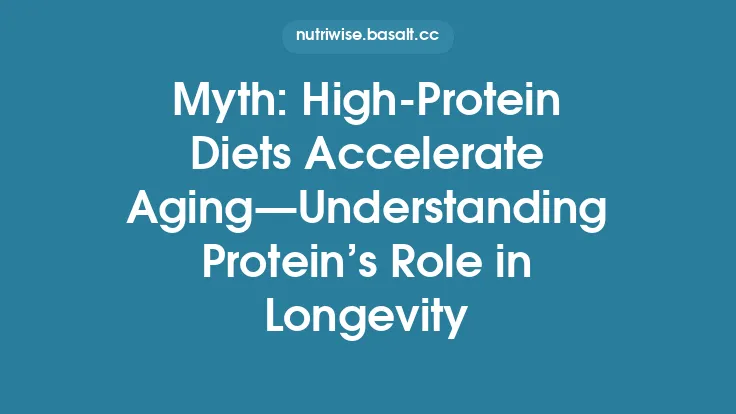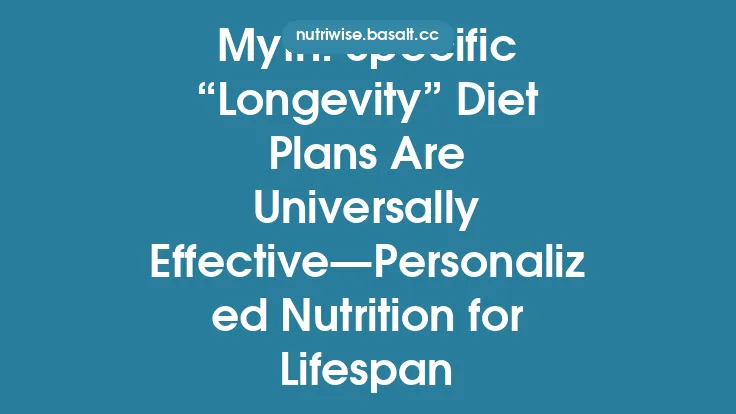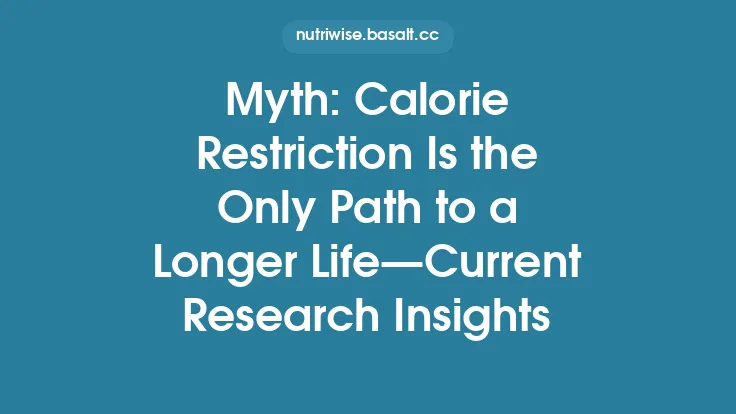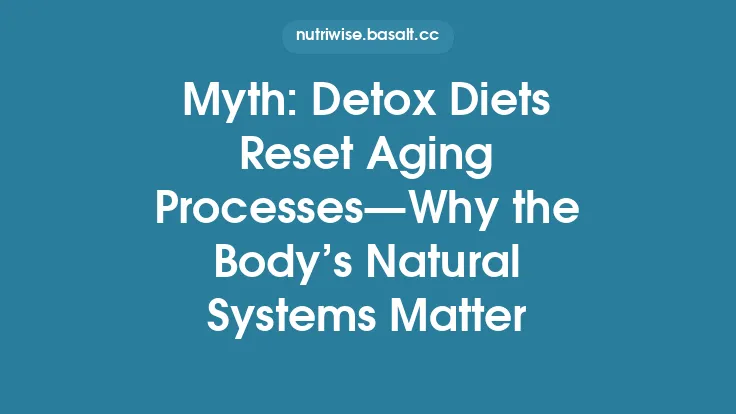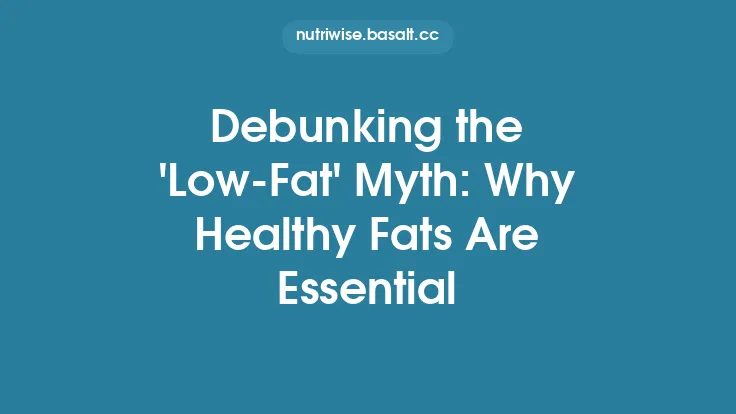Plant‑based eating patterns have captured the public imagination as a silver bullet for a longer, healthier life. Media headlines often proclaim that swapping every animal product for vegetables, legumes, nuts, and fruits will automatically add years to your lifespan. While a diet rich in plant foods is undeniably linked to many health benefits, the notion that it is the *sole* key to longevity is an oversimplification. A nuanced view recognizes that longevity is the product of a complex interplay among genetics, lifestyle, environment, and—yes—diet, but that diet itself must be nutritionally balanced, not merely plant‑centric.
Understanding Longevity: What Science Says About Diet and Aging
Research on human aging consistently points to three dietary themes that support longer, healthier lives:
- Caloric adequacy without chronic excess – Energy intake that meets metabolic needs without persistent over‑consumption reduces oxidative stress and metabolic wear.
- Nutrient density – Foods that provide high amounts of vitamins, minerals, essential fatty acids, and bioactive compounds per calorie support cellular repair and immune function.
- Dietary pattern stability – Long‑term adherence to a consistent eating pattern, rather than short‑term fads, yields the most reliable health outcomes.
Large cohort studies (e.g., the Adventist Health Study‑2, the EPIC‑Oxford cohort) have shown that individuals who consume diets rich in whole plant foods tend to have lower rates of cardiovascular disease, certain cancers, and neurodegenerative conditions—key contributors to mortality. However, these benefits are mediated by *how* the plant‑based diet is constructed, not merely by the exclusion of animal products.
Plant‑Based Diets: Benefits and Limitations
Benefits
- Fiber abundance: Soluble and insoluble fibers improve lipid profiles, glycemic control, and gut motility.
- Phytonutrient load: Polyphenols, carotenoids, and flavonoids exhibit antioxidant and anti‑inflammatory actions that protect endothelial cells and neurons.
- Reduced saturated fat: Lower intake of saturated fatty acids correlates with decreased LDL‑cholesterol and atherosclerotic risk.
Limitations
- Potential nutrient gaps: Certain micronutrients (e.g., vitamin B12, iron, zinc, calcium, iodine, and long‑chain omega‑3 fatty acids) are less bioavailable or present in lower amounts in plant foods.
- Protein quality concerns: Plant proteins often lack one or more essential amino acids in optimal proportions, which can affect muscle maintenance, especially in older adults.
- Caloric density: Whole‑food plant diets can be low in energy density, making it challenging for some individuals to meet caloric needs without large food volumes.
The key takeaway is that a plant‑focused diet can be *health‑promoting* when it is thoughtfully planned to address these limitations.
Essential Nutrients That May Be Challenging on Strict Plant‑Only Regimens
| Nutrient | Primary Plant Sources | Bioavailability Issues | Strategies to Optimize |
|---|---|---|---|
| Vitamin B12 | Fortified plant milks, nutritional yeast, fortified cereals | No reliable natural plant source; gut bacteria synthesis not sufficient | Daily fortified foods or a 2,000–2,500 µg supplement every 2–3 months |
| Iron (non‑heme) | Lentils, chickpeas, tofu, pumpkin seeds, dark leafy greens | Inhibited by phytates and polyphenols; lower absorption than heme iron | Pair with vitamin C‑rich foods, soak/ferment legumes, limit tea/coffee at meals |
| Zinc | Whole grains, legumes, nuts, seeds | Phytate binding reduces absorption | Soak/sprout grains, consume fermented foods, consider a modest supplement if needed |
| Calcium | Fortified plant milks, tofu set with calcium sulfate, kale, bok choy, almonds | Oxalate content in some greens (e.g., spinach) limits absorption | Prioritize low‑oxalate greens, fortified products, or calcium‑rich legumes |
| Iodine | Seaweed (nori, kelp), iodized salt | Variable iodine content in seaweed; excess can affect thyroid | Use iodized salt, limit seaweed to recommended portions (≤ 5 g/day) |
| EPA/DHA (long‑chain omega‑3) | Algal oil supplements, fortified foods | ALA conversion to EPA/DHA is inefficient (≤ 5 %) | Direct algal oil supplementation (250–500 mg EPA+DHA daily) |
Strategies for Achieving Nutrient Balance Within a Plant‑Focused Pattern
- Diverse Food Selection – Rotate legumes, whole grains, nuts, seeds, and a wide spectrum of vegetables and fruits to cover a broad nutrient matrix.
- Culinary Techniques that Enhance Bioavailability – Soaking, sprouting, fermenting, and pressure‑cooking reduce antinutrients (phytates, oxalates) and improve mineral absorption.
- Strategic Pairings – Combine iron‑rich foods with vitamin C sources (e.g., lentils with bell peppers) and consume calcium‑rich foods separate from high‑oxalate meals.
- Fortification and Supplementation – Use fortified plant milks, breakfast cereals, and targeted supplements (B12, vitamin D, iodine, algal omega‑3) to fill inevitable gaps.
- Protein Complementation – Pair complementary plant proteins (e.g., rice + beans, hummus + whole‑grain pita) within the same meal to achieve a complete amino‑acid profile.
The Role of Protein Quality and Quantity in Healthy Aging
Sarcopenia—the age‑related loss of muscle mass and strength—is a major predictor of frailty, falls, and mortality. Adequate protein intake (1.0–1.2 g/kg body weight per day for most older adults) is essential to mitigate this decline. While animal proteins are “complete” (containing all essential amino acids in optimal ratios), plant proteins can meet needs when:
- Total intake is sufficient – Older adults may need slightly higher total protein to compensate for lower digestibility.
- Complementary proteins are combined – Ensuring a balanced profile of lysine, methionine, and tryptophan across meals.
- Leucine‑rich sources are emphasized – Foods such as soy, lentils, pumpkin seeds, and peas provide the branched‑chain amino acid leucine, a key trigger for muscle protein synthesis.
Resistance training synergizes with protein intake, amplifying the anabolic response even in a plant‑based context.
Fats, Omega‑3s, and Their Impact on Cellular Health
Not all fats are created equal. Monounsaturated fatty acids (MUFAs) found in olives, avocados, and nuts improve lipid profiles and insulin sensitivity. Polyunsaturated fatty acids (PUFAs) are divided into:
- Omega‑6 (linoleic acid) – Abundant in many vegetable oils; excessive ratios of omega‑6 to omega‑3 can promote inflammation.
- Omega‑3 (alpha‑linolenic acid, ALA) – Present in flaxseeds, chia seeds, walnuts, and hemp seeds.
Because the conversion of ALA to the long‑chain EPA/DHA forms is limited, many longevity‑focused nutritionists recommend a direct source of EPA/DHA via algal oil supplements. Maintaining an omega‑6:omega‑3 ratio near 4:1 or lower is associated with reduced chronic disease risk and may support telomere stability, a biomarker of cellular aging.
Micronutrients, Phytochemicals, and the Aging Process
- Vitamin D – Essential for bone health, immune modulation, and muscle function. Sun exposure varies by geography; fortified foods or supplements (800–2,000 IU/day) are often required.
- Antioxidant vitamins (C, E, carotenoids) – While the body’s endogenous antioxidant systems are primary, dietary antioxidants help neutralize excess reactive oxygen species generated during metabolism.
- Polyphenols (e.g., resveratrol, quercetin, catechins) – These compounds activate cellular stress‑response pathways (e.g., Nrf2, sirtuins) that enhance DNA repair and mitochondrial function. Their effects are dose‑dependent and synergistic with a balanced diet.
A diet that supplies a broad spectrum of these micronutrients, rather than focusing on a single “super‑nutrient,” aligns best with the concept of *nutrient synergy*—the idea that the combined effect of multiple compounds exceeds the sum of their parts.
Gut Microbiome Interactions with Plant‑Heavy Eating Patterns
High fiber intake fuels short‑chain fatty acid (SCFA) production (acetate, propionate, butyrate) by colonic bacteria. SCFAs:
- Strengthen gut barrier integrity, reducing systemic inflammation.
- Modulate glucose and lipid metabolism via G‑protein‑coupled receptors.
- Influence epigenetic regulation linked to aging pathways.
However, abrupt shifts to very high fiber without gradual adaptation can cause gastrointestinal discomfort and dysbiosis. Introducing a variety of fermentable fibers (inulin, resistant starch, pectin) and allowing the microbiome to adapt over weeks promotes a resilient microbial ecosystem that supports longevity.
Practical Tips for a Balanced, Longevity‑Oriented Eating Plan
| Action | How to Implement |
|---|---|
| Aim for a colorful plate | Include at least three different colors of vegetables/fruits per meal to maximize phytonutrient diversity. |
| Prioritize whole grains | Choose quinoa, brown rice, oats, barley, and farro over refined grains; they provide B‑vitamins, fiber, and minerals. |
| Incorporate legumes daily | Add beans, lentils, or peas to soups, salads, or grain bowls for protein, iron, and zinc. |
| Include nuts & seeds | A handful (≈ 30 g) of mixed nuts or seeds supplies healthy fats, magnesium, and selenium. |
| Schedule fortified foods | Use fortified plant milks or cereals to meet B12, vitamin D, and calcium needs. |
| Supplement strategically | Take B12 (≥ 250 µg daily), vitamin D (if deficient), and algal DHA/EPA (250–500 mg) as advised by a healthcare professional. |
| Combine protein sources | Pair beans with whole grains, or tofu with quinoa, to achieve a complete amino‑acid profile. |
| Mindful cooking | Soak beans 8–12 h, sprout seeds, or ferment vegetables to lower antinutrient levels. |
| Stay hydrated | Adequate water supports fiber digestion and kidney function. |
| Exercise regularly | Combine aerobic activity with resistance training 2–3 times per week to preserve muscle mass and metabolic health. |
Common Misconceptions and How to Evaluate Claims
- “All plant foods are automatically healthy.”
- Processed vegan junk foods (e.g., refined‑grain crackers, sugary plant‑based desserts) can be calorie‑dense and nutrient‑poor. Evaluate foods based on whole‑food content, not just plant origin.
- “If I eat only plants, I’ll never need supplements.”
- Certain nutrients (B12, EPA/DHA, iodine) are not reliably obtained from unfortified plant sources. Look for evidence‑based supplementation recommendations.
- “More protein from plants equals better longevity.”
- Excess protein, regardless of source, may increase renal load and affect insulin‑like growth factor pathways. Balance protein intake with overall energy needs and activity level.
- “All vegans live longer than omnivores.”
- Longevity studies adjust for confounders such as socioeconomic status, smoking, and physical activity. The protective effect is linked to diet quality, not merely the exclusion of animal products.
When assessing a claim, ask: *Is the evidence derived from long‑term, well‑controlled human studies? Does it account for overall dietary pattern and lifestyle?*
Summary: A Holistic View of Diet and Longevity
A plant‑based diet can be a powerful component of a longevity‑promoting lifestyle, offering abundant fiber, phytonutrients, and a favorable fatty‑acid profile. However, longevity is not guaranteed by plant foods alone. The critical factor is nutrient balance—ensuring adequate intake of high‑quality protein, essential micronutrients, and long‑chain omega‑3 fatty acids, while supporting gut health and metabolic resilience.
By:
- Selecting a diverse array of whole plant foods,
- Employing preparation methods that enhance nutrient bioavailability,
- Using fortified foods or targeted supplements to close inevitable gaps, and
- Pairing dietary habits with regular physical activity and other healthy behaviors,
individuals can harness the benefits of plant‑centric eating without falling into the trap of a one‑size‑fits‑all myth. Longevity, after all, is a marathon, not a sprint, and the most sustainable dietary strategy is one that meets the body’s complex nutritional demands while fitting comfortably into a person’s cultural, social, and personal context.
